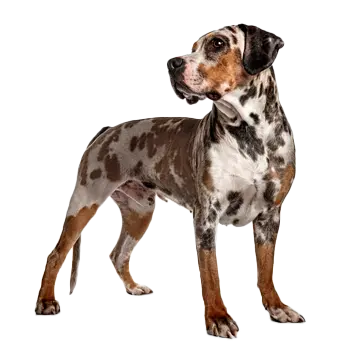Catahoula Leopard Dogs are generally healthy, robust dogs with typical lifespans ranging from 10 to 14 years when provided with proper nutrition, exercise, and veterinary care. Their working heritage has contributed to overall soundness and hardiness. However, like all purebred dogs, they have predisposition to certain health conditions that potential owners should understand. Responsible breeders conduct health testing on breeding stock to minimize risks of hereditary problems in puppies.
Hip dysplasia represents one of the more common orthopedic issues affecting Catahoulas. This developmental condition occurs when the hip joint forms improperly, causing the femoral head to fit poorly in the hip socket. The resulting poor fit leads to joint instability, cartilage damage, inflammation, and eventually arthritis. Severity varies from mild cases causing minimal symptoms to severe dysplasia resulting in significant pain and mobility impairment. While genetics play the primary role, environmental factors including growth rate, nutrition, and exercise during puppyhood also influence development. Responsible breeders have parent dogs evaluated through hip radiographs scored by organizations like the Orthopedic Foundation for Animals. Buyers should request hip scores before purchasing puppies.
Deafness occurs in Catahoulas with concerning frequency, particularly in dogs with predominantly white coats or those carrying double copies of the merle gene. The genetic factors causing the distinctive merle coat pattern can also affect development of structures in the inner ear necessary for hearing. Congenital deafness may affect one ear or both ears and is present from birth. Breeders should conduct BAER testing on all puppies before placement to determine hearing status. While deaf dogs can become wonderful pets with training using visual signals and vibrations, potential owners should make informed decisions about whether they can successfully manage a deaf dog.
Progressive retinal atrophy is an inherited eye disease causing gradual degeneration of the retina, ultimately leading to blindness. Early signs include night blindness and dilated pupils, progressing to complete vision loss. No treatment exists for PRA, though affected dogs typically adapt well to blindness in familiar environments. Genetic testing identifies dogs carrying the mutation, allowing breeders to make informed decisions. Other eye conditions including microphthalmia, where eyes are abnormally small, and cataracts also occur. Regular ophthalmologic examinations help detect eye problems early.
Bloat, properly called gastric dilatation-volvulus, poses serious risk for deep-chested breeds like Catahoulas. This life-threatening emergency occurs when the stomach fills with gas and twists on itself, cutting off blood supply and preventing the dog from relieving pressure through vomiting or belching. Without immediate emergency surgical intervention, bloat rapidly causes shock and death. Risk factors include eating large meals rapidly, exercising vigorously before or after eating, drinking large amounts of water quickly, stress, and genetic predisposition. Preventive measures include feeding smaller meals multiple times daily, using slow-feeder bowls, avoiding exercise around mealtimes, and minimizing stress. Owners should learn to recognize bloat symptoms including unproductive retching, distended abdomen, restlessness, and rapid breathing, seeking emergency care immediately if bloat is suspected.
Chondrodystrophy and associated intervertebral disc disease affect some Catahoulas. This skeletal disorder causes abnormal cartilage development, potentially leading to shortened limbs and premature degeneration of spinal discs. Early disc degeneration predisposes dogs to disc herniation, causing pain, nerve damage, and potentially paralysis. Hyperuricosuria is a metabolic condition causing elevated uric acid in urine, predisposing affected dogs to formation of urinary stones in bladder or kidneys. Genetic testing identifies carriers of the mutation.
Cancers occur in older Catahoulas as they do in most dog breeds. Various cancer types may develop, with regular veterinary examinations helping detect tumors early when treatment options are most effective. Skin cancers can affect dogs with lighter pigmentation, making sun protection advisable for white or lightly-marked dogs spending extensive time outdoors.
Preventive health care forms the foundation of keeping Catahoulas healthy throughout life. Regular veterinary check-ups, typically annually for adults and semi-annually for senior dogs, allow early detection of developing problems before they become serious. Comprehensive physical examinations should include weight assessment, dental evaluation, joint palpation, and discussion of any changes in behavior, appetite, or activity level. Maintaining appropriate body weight prevents or minimizes many health problems including joint disease, diabetes, and heart conditions. Obesity significantly impacts quality and length of life.
Vaccinations protect against serious infectious diseases, with protocols tailored to individual dog risk factors and geographic location. Core vaccines include rabies, distemper, parvovirus, and adenovirus. Optional vaccines depend on lifestyle and exposure risks. Annual parasite prevention through year-round heartworm preventative and flea and tick control protects against these common parasites and the diseases they transmit. Dental care through regular teeth brushing and professional cleanings prevents periodontal disease that can affect heart, kidney, and liver health. Blood work and health screenings become increasingly important as dogs enter senior years, helping detect conditions like kidney disease, liver problems, or thyroid dysfunction before clinical signs appear.
Common Health Issues
- Hip dysplasia represents one of the more common orthopedic issues affecting Catahoulas.
- Regular ophthalmologic examinations help detect eye problems early.
- Chondrodystrophy and associated intervertebral disc disease affect some Catahoulas.
- Cancers occur in older Catahoulas as they do in most dog breeds.
- Various cancer types may develop, with regular veterinary examinations helping detect tumors early when treatment options are most effective.
- Skin cancers can affect dogs with lighter pigmentation, making sun protection advisable for white or lightly-marked dogs spending extensive time outdoors.
Preventive Care & Health Monitoring
- Catahoula Leopard Dogs are generally healthy, robust dogs with typical lifespans ranging from 10 to 14 years when provided with proper nutrition, exercise, and veterinary care.
- While genetics play the primary role, environmental factors including growth rate, nutrition, and exercise during puppyhood also influence development.
- Preventive measures include feeding smaller meals multiple times daily, using slow-feeder bowls, avoiding exercise around mealtimes, and minimizing stress.
- Various cancer types may develop, with regular veterinary examinations helping detect tumors early when treatment options are most effective.
Regular veterinary check-ups and preventive care are essential for maintaining your Catahoula Leopard Dog's health and longevity.

